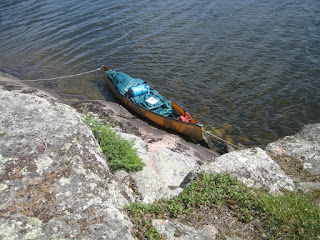Up at 3:20 am at camp 14 on July 8, it seems darker than it should be and I soon discover why. A light steady drizzle starts, keeping up for two hours. The mosquitoes are very bothersome so I don my headnet to take down the tent. I place all the gear under the tarp shelter, the first time I have used it except to store the usual items (barrel, pots and pans, kindling and birch bark). The canoe is tied along shore in a safer spot than the original where I would now be falling into the water from the steep wet slope. Getting the packs in the front half of the canoe, I then take down the tarp shelter to cover the load. I place the remaining gear in the canoe and cover with the tarp. After doing all the sweaty work, I put on my raingear, and shove off without breakfast or bathroom. For the first three km the wind is against me, but then I turn and have a quartering tailwind and stop for bathroom, breakfast and a first lunch. Thankfully the rain stops. As I move on, the waves get progressively larger when I cross two sets of two km of open water. Later turning into the wind, it is a very hard slog across a three km stretch of lake, first paddling out of my way to the side as far as possible in the lee of shoreline before turning into the headwind to cross the wide bay.
Tired and ready to stop after travelling 20 km, my mantra becomes "Come on campsite, come on campsite ...". The windward side of a likely looking island campsite, is way too exposed. When I canoe to the leeward side, lo and behold there is a very good looking candidate. Landing, I spot a good tent site right away, needing only the removal of some small branches. There is a big inland expanse of bare rock for a fireplace. Yeah! Where I parked the canoe is way too steep and high, so I move it farther down the shoreline where there is a reasonable climb up.
The expansive view across the lake is beautiful. Hopefully the wind will not switch to the opposite direction as this site would then be very exposed.
This proves to be the easiest camp to set up so far, only requiring a few small trees to be felled where the tarp needs to go. Note that I now usually fasten the tarp shelter higher than I used to. The front is at least shoulder height so that when I place a supporting pole, I can easily walk under without stooping. The back of the tarp I situate about one metre from the ground. The 10' x 14' (3 x 4 m) tarp is the ideal size, much bigger than the tarp I used to use. No matter that I have been camping for decades, I keep finding improvements in use of gear or better equipment, a far cry from homemade items I used as a landlocked farm kid.
Not wanting to drag the canoe over bare rock up two metres vertical, I set it behind a boulder close to shore. Wanting to protect the canoe if a strong wind arises, I secure it at both ends by threading the painters through the bow and stern thwarts, then under the canoe and over, tied off to small trees. The wind cannot blow the canoe over and away.
There is a natural spot for a fireplace, a levelish spot nearby to sit, lots of firewood, deep moss nearby for a "fridge", a good bathing spot ...
... and a beautiful view.






